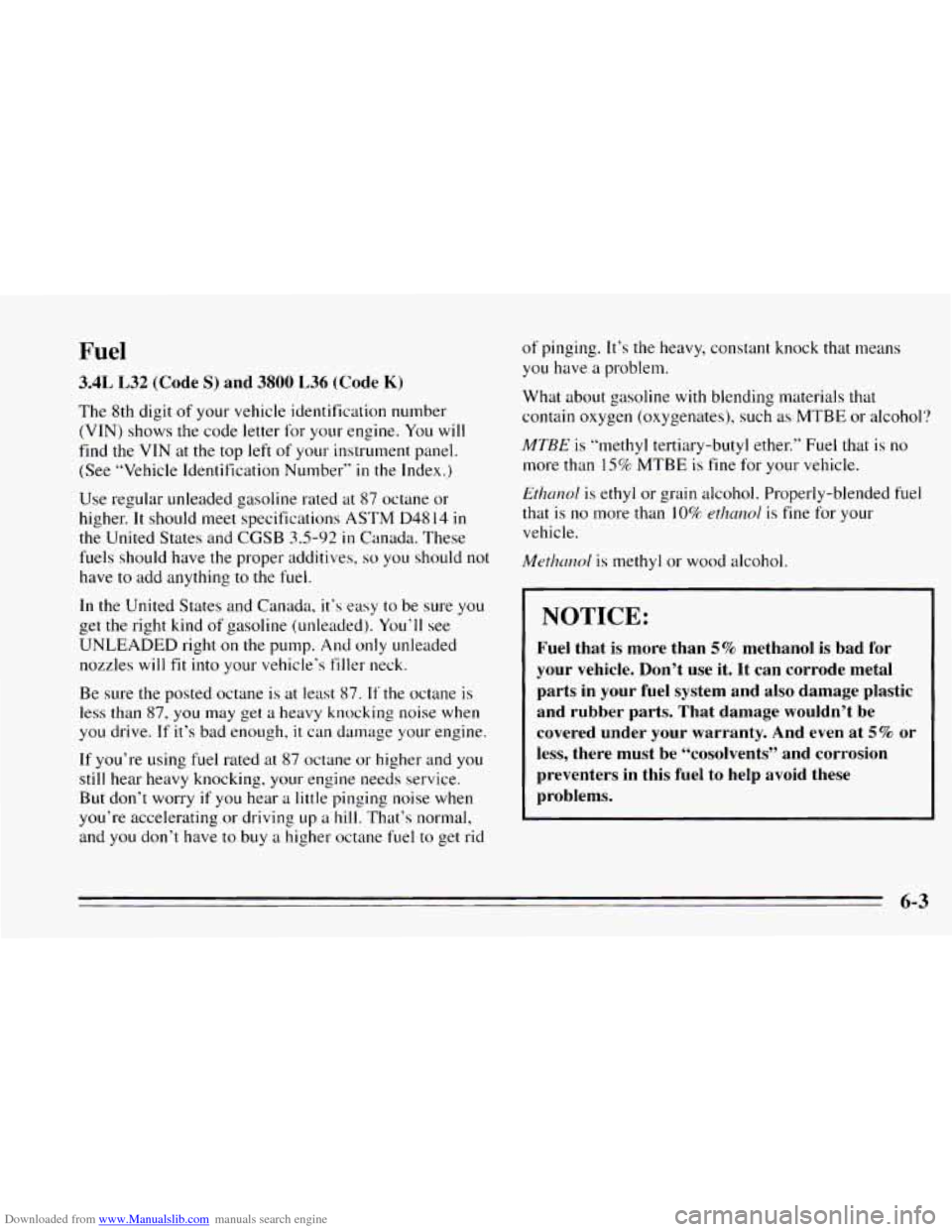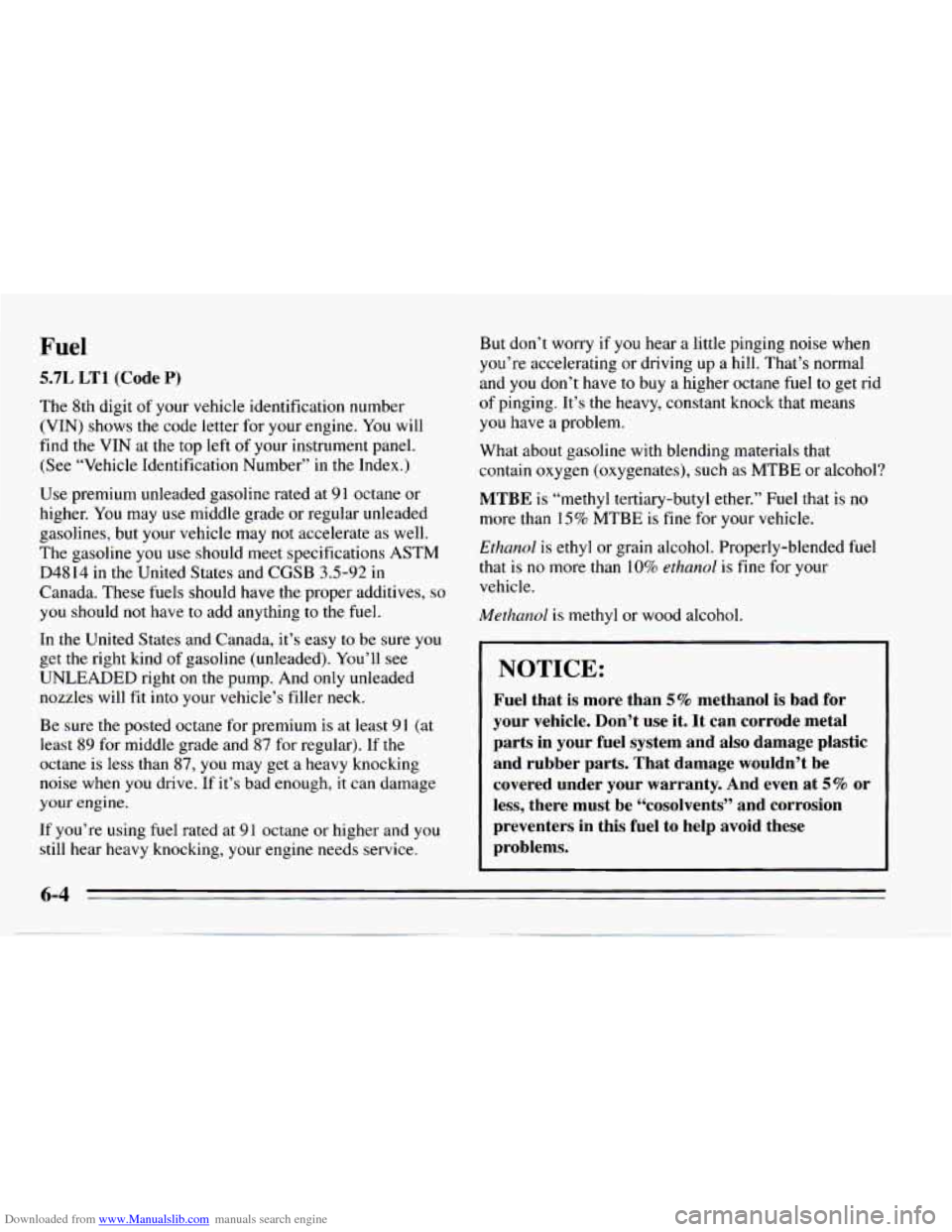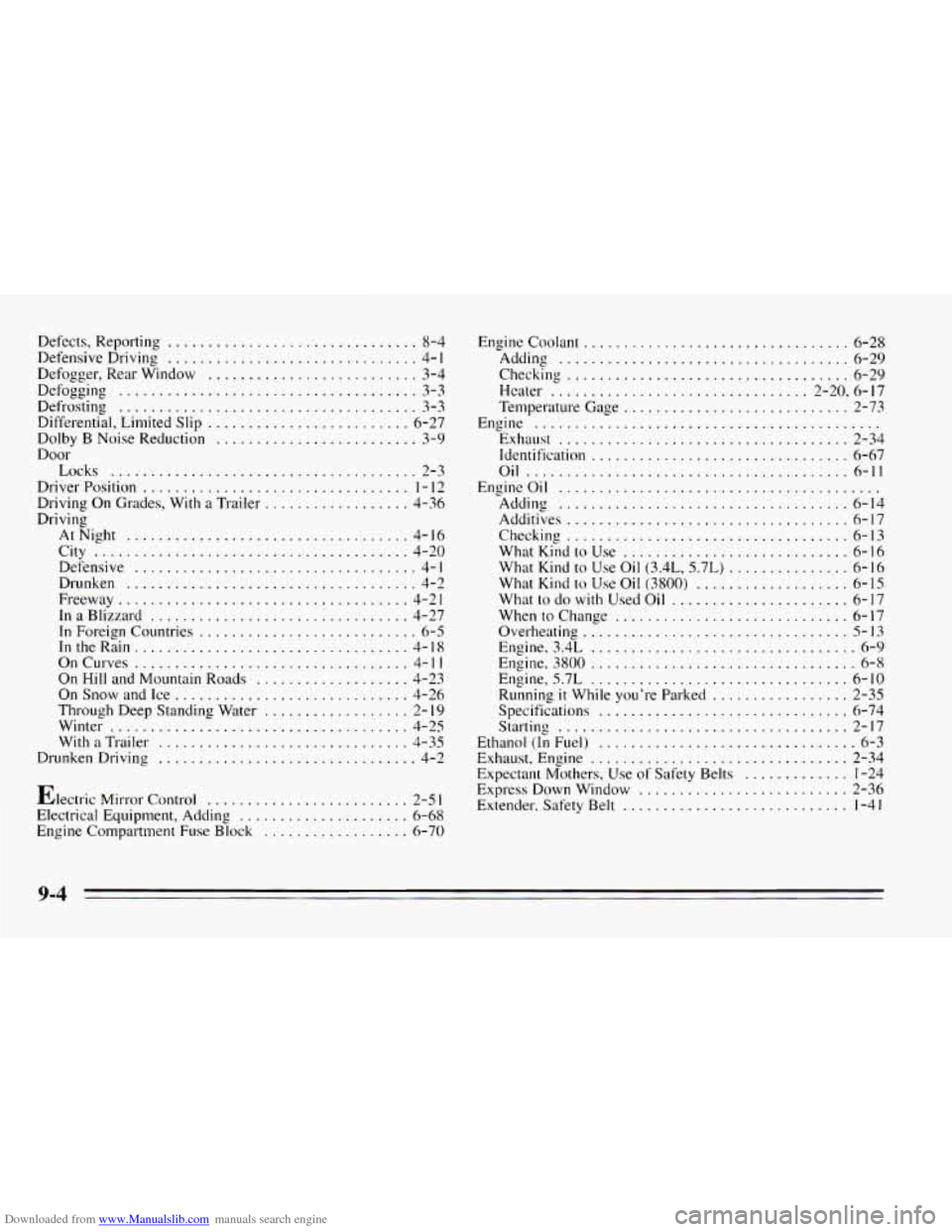1995 CHEVROLET CAMARO fuel additives
[x] Cancel search: fuel additivesPage 235 of 388

Downloaded from www.Manualslib.com manuals search engine Fuel
3.4L L32 (Code S) and 3800 L36 (Code K)
The 8th digit of your vehicl,e identification number
(VIN) shows the code letter for your engine. You will
find the
VIN at the top left of your instrument panel.
(See “Vehicle Identification Number”
in the Index.)
Use regular unleaded gasoline rated at
87 octane or
higher.
It should meet specifications ASTM D4814 in
the United States and CGSB 3.5-92 in Canada. These
fuels should have the proper additives,
so you should not
have to add anything to the fuel.
In the United States and Canada, it‘s easy to be sure you
get
the right kind of gasoline (unleaded). You’ll see
UNLEADED right on the pump, And only unleaded
nozzles will
fit into your vehicle‘s filler neck.
Be sure the posted octane is at least
87. If‘ the octane is
less than
87, you may get a heavy knocking noise when
you drive. If it’s bad enough, it can damage your engine.
If you’re using fuel rated at
87 octane or higher and you
still hear heavy knocking, your engine needs service.
But don’t worry
if you hear a little pinging noise when
you’re accelerating or driving up
a hill. That’s normal,
and
you don’t have to buy a higher octane fuel to get rid of
pinging. It’s the heavy, constant knock that means
you have a problem.
What about gasoline
with blending materials that
contain oxygen (oxygenates), such as
MTBE or alcohol?
MTBE is “methyl tertiary-butyl ether.” Fuel that is no
more than
15% MTBE is fine for your vehicle.
Etl?mol is ethyl or grain alcohol. Properly-blended fuel
that is no more than 10%
ethuuol is fine for your
vehicle.
Metlwrnof is methyl or wood alcohol.
NOTICE:
Fuel that is more than 5% methanol is bad for
your vehicle. Don’t use it.
It can corrode metal
parts in your fuel system and also damage plastic
and rubber parts. That damage wouldn’t be
covered under your warranty. And even at
5% or
less, there must be “co~oIvent~’’ and corrosion
preventers in this fuel to help avoid these
problems.
6-3
Page 236 of 388

Downloaded from www.Manualslib.com manuals search engine Fuel
5.7L LT1 (Code P)
The 8th digit of your vehicle identification number
(VIN) shows the code letter for your engine.
You will
find the
VIN at the top left of your instrument panel.
(See “Vehicle Identification Number” in the Index.)
Use premium unleaded gasoline rated at
91 octane or
higher.
You may use middle grade or regular unleaded
gasolines, but your vehicle may
not accelerate as well.
The gasoline you use should meet specifications ASTM
D4814 in the United States and
CGSB 3.5-92 in
Canada. These fuels should have the proper additives,
so
you should not have to add anything to the fuel.
In the United States and Canada, it’s easy to be sure you
get the right kind of gasoline (unleaded). You’ll see
UNLEADED right on the pump. And
only unleaded
nozzles will fit into your vehicle’s filler neck.
Be sure the posted octane for premium is at least
9 I (at
least
89 for middle grade and 87 for regular). If the
octane is less than
87, you may get a heavy knocking
noise when
you drive. If it’s bad enough, it can damage
your engine.
If you’re using fuel rated at
9 1 octane or higher and you
still hear heavy knocking, your engine needs service. But don’t worry
if
you hear a little pinging noise when
you’re accelerating or driving up
a hill. That’s normal
and
you don’t have to buy a higher octane fuel to get rid
of pinging.
It’s the heavy, constant knock that means
you have a problem.
What about gasoline with blending materials that
contain oxygen (oxygenates), such as MTBE or alcohol?
MTBE is “methyl tertiary-butyl ether.’’ Fuel that is no
more than 15% MTBE is fine for your vehicle.
Ethanol is ethyl or grain alcohol. Properly-blended fuel
that
is no more than 10% ethanol is fine for your
vehicle.
Methanol is methyl or wood alcohol.
I NOTICE:
Fuel that is more than 5% methanol is bad for
your vehicle. Don’t use it. It can corrode metal parts in your fuel system and also damage plastic
and rubber parts. That damage wouldn’t be
covered under your warranty. And even at
5% or
less, there must be “cosolvents” and corrosion
preventers in this fuel to help avoid these
problems.
6-4
Page 237 of 388

Downloaded from www.Manualslib.com manuals search engine Gasolines for Cleaner Air
Your use of gasoline with deposit control additives will
help prevent deposits from forming
in your engine and
fuel system. That helps keep your engine in tune and
your emission control system working properly. It’s
good for your vehicle, and you’ll be doing your part for
cleaner air.
Many gasolines are now blended with oxygenates.
General Motors recommends that you use gasolines with
these blending materials, such as MTBE and ethanol. By
doing
so, you can help clean the air, especially in those
parts of the country that have high carbon monoxide
levels.
In addition, some gasoline suppliers are now producing
reformulated gasolines. These gasolines are specially
designed
to reduce vehicle emissions. General Motors
recommends that you use reformulated gasoline. By
doing
so, you can help clean the air, especially in those
parts
of the country that have high ozone levels.
You should ask your service station operators if their
gasolines contain deposit control additives and oxygenates, and
if they have been reformulated to
reduce vehicle emissions.
Fuels in Foreign Countries
If you plan on driving in another country outside the
U.S. or Canada, unleaded fuel may be hard to find. Do
not use leaded gasoline. If you use even one tankful,
your emission controls won’t work well or at all. With
continuous
use, spark plugs can get fouled, the exhaust
system can corrode, and your engine oil can deteriorate
quickly. Your vehicle’s oxygen sensor will be damaged.
All of that means costly repairs that wouldn’t be covered
by your warranty.
To check on fuel availability, ask an auto club, or
contact a major oil company that does business in the
country where you’ll be driving.
You can also write us at the following address for
advice. Just tell us where you’re going and give your
Vehicle Identification Number (VIN).
General Motors Overseas Distribution Corporation
North American Export Sales (NAES)
1908 Colonel Sam Drive
Oshawa, Ontario
L1H 8P7
6-5
Page 378 of 388

Downloaded from www.Manualslib.com manuals search engine Defects. Reporting ............................... 8-4
Defensive Driving
............................... 4- 1
Defogging ..................................... 3-3
Defrosting
..................................... 3-3
Differential. Limited Slip
......................... 6-27
Dolby
B Noise Reduction ......................... 3-9
Door Locks
...................................... 2-3
Driver Position
................................. 1 - I2
Driving On Grades. With a Trailer .................. 4-36
Driving At Night
................................... 4- I6
City ....................................... 4-20
Defensive
................................... 4-1
Drunken
.................................... 4-2
Freeway
.................................... 4-21
In
a Blizzard ................................ 4-27
In Foreign Countries ........................... 6-5
In the Rain
.................................. 4-18
OnCurves
.................................. 4-11
On
Hill and Mountain Roads ................... 4-23
On Snow and Ice
............................. 4-26
Through Deep Standing Water
.................. 2- 19
Winter ..................................... 4-25
With
a Trailer ............................... 3-35
Drunken Driving
................................ 4-2
Defogger. Rear
Window
.......................... 3-4
Electric Mirror Control
......................... 2-5 I
Electrical Equipment. Adding ..................... 6-68
Engine Compartment
Fuse Block .................. 6-70 Engine Coolant
................................. 6-28
Adding
.................................... 6-29
Checking
................................... 6-29
Heater
................................ 2.20. 6-i7
Temperature Gage
............................ 2-73
Exhaust
.................................... 2-34
Identification
................................ 6-67
Oil ........................................ 6-11
Engineoil ........................................
Additives ................................... 6-17
Checking
................................... 6-13
What Kind to Use ............................ 6-16
What Kind to Use Oil (3.4L, 5.7L)
............... 6-16
What Kind to Use Oil (3800) ................... 6-15
What to do with Used Oil ....................... 6-17
Whentochange
............................. 6-17
Overheating
................................. 5-13
Engine. 3.4L ................................. 6-9
Engine.
3800 ................................. 6-8
Engine. 5.7L ................................ 6-10
Running it While you’re Parked ................. 2-35
Specifications
............................... 6-74
Ethanol
(In Fuel) ................................ 6-3
Expectant Mothers. Use
of Safety Belts ............. 1-24
Express Down Window
.......................... 2-36
Extender. Safety Belt
............................ 1-41
Engine
...........................................
Adding .................................... 6-14
Starting
.................................... 2-17
Exhaust. Engine
................................ 2-34
9-4